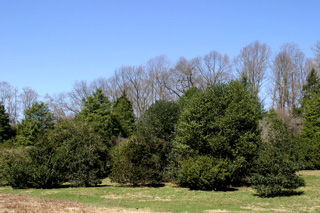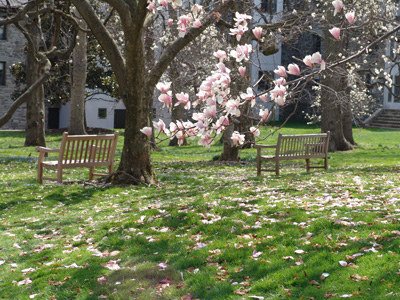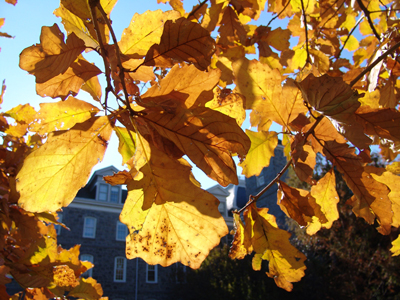NAPCC Collections at the Scott Arboretum
 In the Nov/Dec 2011 issue of the American Gardener there is a wonderful article describing the effort of the North American Plant Collection Consortium (NAPCC).
In the Nov/Dec 2011 issue of the American Gardener there is a wonderful article describing the effort of the North American Plant Collection Consortium (NAPCC).
The NAPCC is part of the American Public Gardens Association (APGA). The NAPCC is an advocate for raising plant curation, plant records, and collections management standards. It is also a seal of approval for plant collections found in botanical gardens and arboreta that exhibit exemplary collections of plants throughout North America.

James R. Frorer Holly Collection is located on a south facing slope along the Crum Creek. photo credit: D. Mattis
The Scott Arboretum holds three NAPCC collections including Ilex, hollies; Quercus, oaks; and Magnolia. Our first collection to get NAPCC status was the holly collection. The lion’s share of this collection is found in the James R. Frorer Holly Collection on the south facing slopes along the Crum Creek. This collection was donated by Swarthmore College graduate, James R. Frorer in 1974 from his property in Wilmington, Delaware. Today, the collection represents over 290 different kinds of hollies.

There are some great rest spots found among the blossoms of the Magnolia Collection. photo credit: J. Jin
Another significant collection with NAPCC status is our Magnolia Collection. Historically, the “collection” existed around Mertz Dormitory, Worth Health Center, and the Benjamin West House. Over the last 15 years due to growth of the collection we have expanded out magnolia plantings to the West Garden, Tree Peony Garden, Sharples Dining Hall, and the Pinetum. The collection is rich in species, cultivars, and hybrids, representing over 150 taxa.

Fall color of the majestic Quercus phellos. photo credit: R. Manduca
Our most recent NAPCC collection is the oaks. We are part of a multi-institution group which represents the genus, Quercus in North America. Because oaks are found in many geographical regions of the world it is prudent to have a variety of institutions collectively hold this collection. For example, the UC Davis Arboretum can grow the California and Mexican oaks while the Scott Arboretum can focus on Eastern U. S. native species along with European and Asian species and cultivars.

Quercus bicolor with lovely fall color. photo credit: R. Manduca
Each of the three collections span the entire Arboretum. Exploring any of these collections will open your eyes to the range of plants growing here at Scott Arboretum.





No Comments